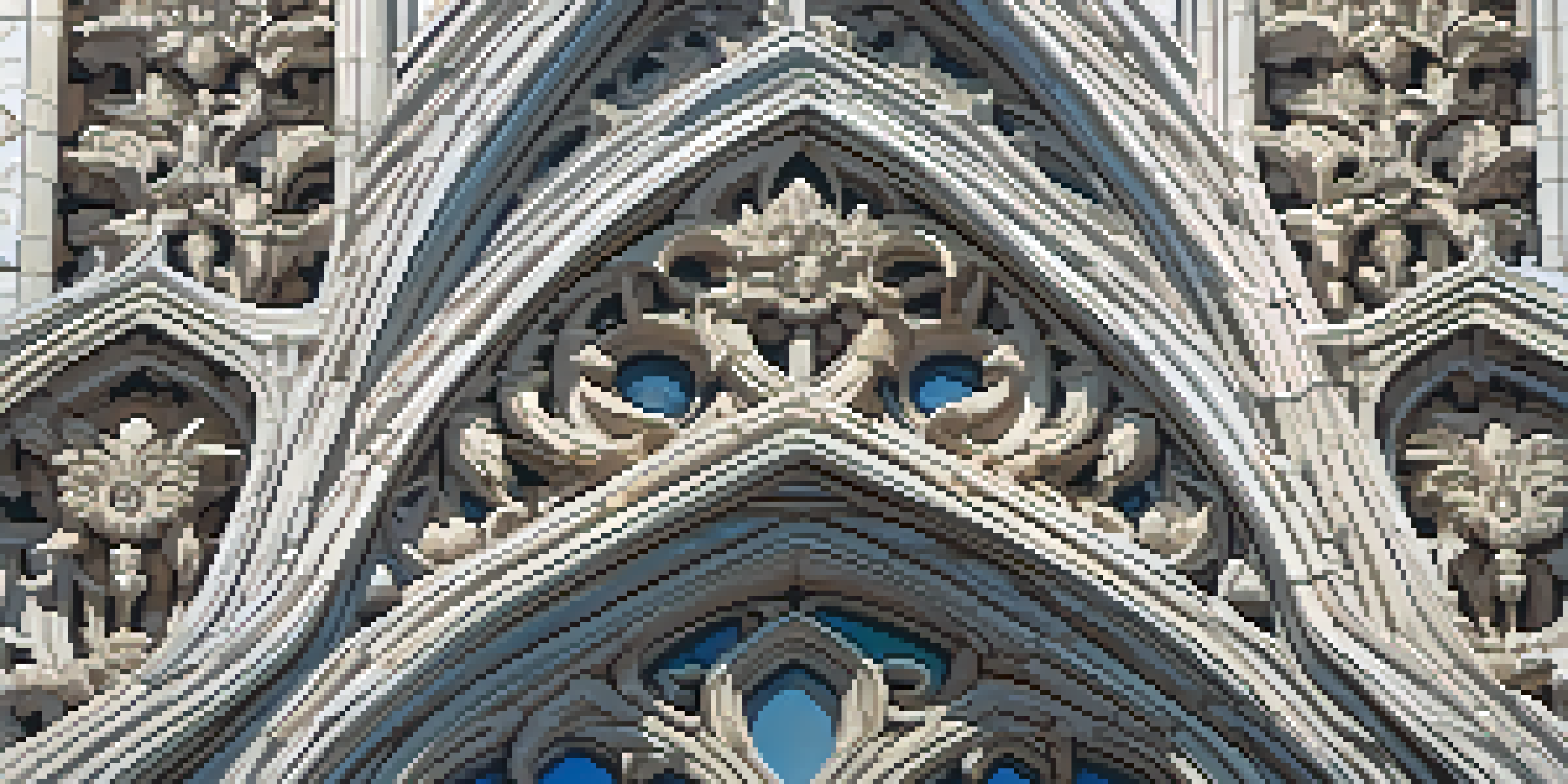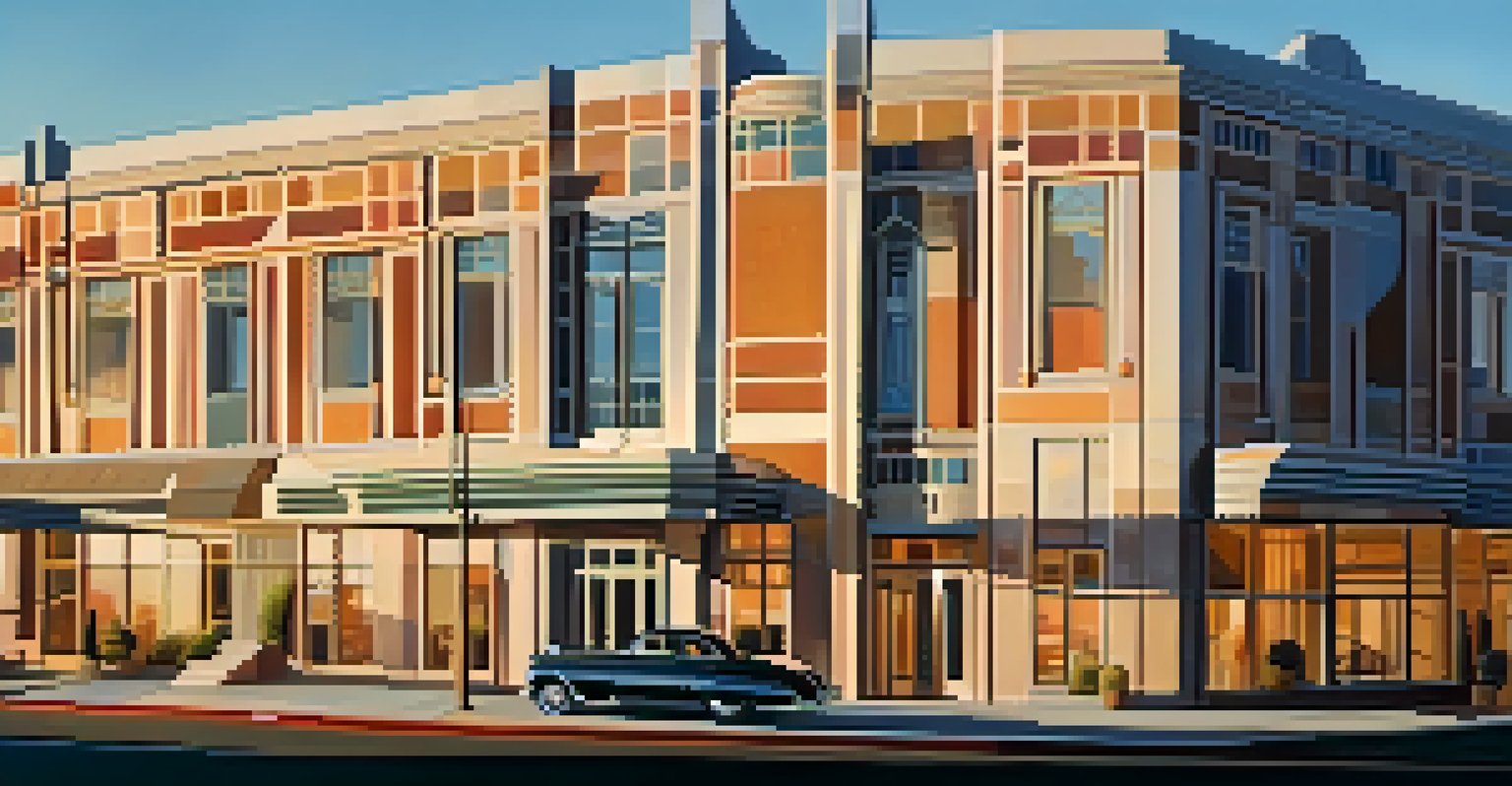Symbolism in Carvings on Architectural Elements

The Role of Symbolism in Architectural Carvings
Symbolism in carvings serves as a visual language, conveying deeper meanings that transcend mere aesthetics. These intricate designs often reflect cultural beliefs, historical events, or spiritual ideologies. For example, ancient Egyptian temples featured carvings depicting gods and pharaohs, emphasizing their divine connection and power.
Architecture is the learned game, correct and magnificent, of forms assembled in the light.
As architecture evolved, so did the use of symbols, adapting to the changing values and ideas of society. Gothic cathedrals, for instance, utilized gargoyles not only for functional purposes but also to ward off evil spirits, blending artistry with practical design. This integration of symbolism into everyday structures creates a dialogue between the building and its beholders.
Ultimately, these carvings invite viewers to engage with the space on a more profound level, prompting them to consider the stories behind the symbols. As we explore various architectural styles, we uncover layers of meaning that enhance our appreciation for these artistic expressions.
Common Symbols Found in Architectural Carvings
Throughout history, certain symbols have emerged repeatedly in architectural carvings, each carrying its unique significance. For example, the lotus flower symbolizes purity and rebirth, often seen in Asian temples. Similarly, the acanthus leaf is a common motif in Corinthian columns, representing immortality and beauty.

Animals also play a significant role in architectural symbolism. The lion, often associated with strength and courage, can be found adorning the entrances of castles and public buildings. Meanwhile, the owl, a symbol of wisdom, is frequently depicted in educational institutions, reinforcing the value of knowledge.
Symbolism Reflects Cultural Values
Architectural carvings serve as a visual language that conveys deeper meanings related to cultural beliefs and historical narratives.
These recurring motifs not only provide insight into the values and beliefs of the cultures that created them but also serve to unify various structures under a common aesthetic. By recognizing these symbols, we can appreciate the layers of meaning embedded in the architecture around us.
Cultural Significance of Carvings in Architecture
Carvings in architecture often reflect the cultural heritage of a society, showcasing its values and traditions. For instance, Native American totem poles are rich in symbolism, representing ancestral stories and clan identities. Each figure carved onto the pole carries specific meanings, creating a narrative that connects the community to its history.
Symbols are the language of the unseen, and they make the invisible visible.
In contrast, Islamic architecture features intricate geometric patterns and calligraphy, emphasizing the importance of spirituality and the divine. These designs often avoid depicting human figures, aligning with religious beliefs while still conveying profound messages through art.
By examining these cultural expressions, we gain a deeper understanding of how societies communicate their identity and beliefs through architecture. The carvings tell stories that resonate through time, inviting us to explore the richness of human experience.
Evolution of Symbolism in Architectural Styles
As architectural styles evolved, so did the use of symbolism, adapting to contemporary values and aesthetics. The Renaissance period, for instance, saw a resurgence of classical motifs, blending ancient symbolism with modern ideals of beauty and harmony. This fusion reflects a society that revered its past while looking forward to new possibilities.
In the 20th century, movements like Art Deco began to incorporate bold geometric forms and stylized motifs, shifting the focus from traditional symbolism to a celebration of modernity and progress. This transition illustrates how symbolism can evolve, reflecting the changing priorities and aspirations of society.
Evolution of Symbolism Over Time
As architectural styles evolve, the use of symbolism adapts to reflect contemporary values and aesthetics, illustrating cultural changes.
Understanding this evolution allows us to appreciate how architecture acts as a mirror of cultural trends and ideas. Each style carries with it a set of symbols that resonate with the people of its time, creating a visual narrative of human progress.
Interpreting Symbolism: Different Perspectives
Interpreting symbolism in architectural carvings can vary greatly between cultures and individuals. What one group sees as a representation of strength, another might interpret as a sign of oppression. This subjectivity adds layers of complexity to our understanding of these symbols.
For example, the swastika, which carries positive meanings in some Eastern traditions, has been appropriated by Western cultures to represent hate and division. This shift in meaning illustrates how context and history influence our perceptions of symbols.
This diversity of interpretation invites us to approach architectural symbolism with an open mind, encouraging dialogue and exploration. By engaging with various perspectives, we enrich our understanding of the cultural significance behind these carvings.
The Impact of Modern Technology on Symbolism
In today's digital age, modern technology is reshaping how we create and interpret symbolism in architecture. Advanced tools allow architects to experiment with new forms and materials, leading to innovative designs that challenge traditional notions of symbolism. For instance, 3D printing enables the creation of intricate patterns that were once labor-intensive to carve by hand.
Moreover, the rise of virtual reality and augmented reality allows us to experience architectural symbolism in immersive ways. These technologies can enhance our understanding of how symbols interact within a space, providing a new dimension to our appreciation of architectural art.
Preserving Architectural Symbolism
Efforts to preserve symbolic carvings in architecture are vital for maintaining cultural identity and ensuring future generations appreciate these narratives.
As we embrace these technological advancements, we also have the opportunity to redefine what symbolism means in the context of contemporary architecture. This evolving landscape inspires us to consider how future generations will interpret the symbols we create today.
Preserving Symbolism in Architectural Heritage
Preserving the symbolism embedded in architectural heritage is crucial for maintaining cultural identity and history. As cities modernize, there is a risk of losing these intricate carvings that tell the stories of our past. Efforts to document and restore historical buildings are essential in ensuring that future generations can appreciate and learn from these symbols.
Organizations and communities are increasingly recognizing the importance of preserving these architectural elements, often engaging in restoration projects that honor the original craftsmanship. Initiatives like these not only protect our cultural heritage but also foster a sense of pride and connection to our roots.

By valuing the symbolism found in architectural carvings, we encourage a deeper appreciation for our built environment. This commitment to preservation ensures that the stories behind these symbols continue to resonate, enriching our understanding of history and culture.